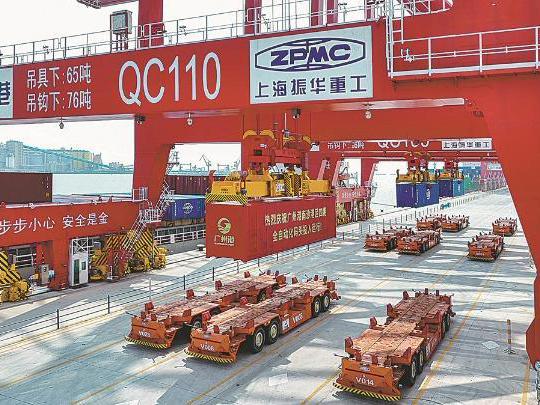The Port of Nansha, located in the city of Guangzhou, unveiled the operation of its fully automated terminal on July 28, 2022. The port’s fully automated container terminal features fully automated gantry cranes and self-driving trucks and is the first fully automated terminal built in the Guangdong-Hong Kong-Macao Greater Bay Area.
The automated terminal is part of the fourth phase of the modernization project at the Port of Nansha which will combine multimodal services related to sea, river, and railway transportation in the area, according to Guangzhou Port Group (GPG). The fourth phase of the port also includes four 100,000 metric-ton berths and their supporting container barge berths.

The terminal incorporates a new generation of automated container terminal technology by using new machines from automation equipment hardware to information systems. The new machinery led to the filing of more than 60 patents, including 31 classified as invention patents, according to the GPG. "The terminal, which features smart and independent operations and low-carbon emissions, has contributed to the promotion of automated wharf technology," said Li Yibo, Chairman of GPG. Li added that with the onset of operations, the new terminal will be integrated with the Nansha port's other terminals to form a specialized and large-scale terminal cluster, helping to greatly improve the port's handling capacity.
According to the GPG, the new terminal has a designed annual throughput capacity of 4.9 million TEUs. The annual container throughput of the entire Nansha port is expected to exceed 24 million TEUs.
At the launching ceremony, Li said, "It will help enhance the function of the international comprehensive transportation hub and provide strong support for Nansha to build itself into a major strategic high-level shipping and logistics platform in the Greater Bay Area, in coordination with Hong Kong and Macao."
It’s anticipated the terminal’s fully automated operation, will help inject momentum into the implementation of an overall plan to promote comprehensive cooperation among Guangdong, Hong Kong and Macao, the company said.
Nansha’s State of the Art Automated Terminal complements their new International Logistics Facility that offers both Dry and Cold Warehousing along with their new On Dock Rail. These new value added services have drawn the attention of many shippers, carriers, and especially E Commerce Shippers who require Air-Sea+Rail offerings.
The development of a joint shipping and logistics trade center and construction of a world-class port cluster in the Greater Bay Area has become part of that plan, which was issued in June by the State Council, China's Cabinet.
The terminal has also become a green environmental protection demonstration project in the port industry, as it achieves zero emissions following the use of technologies such as the new generation of Internet of Things sensing, big data analysis, artificial intelligence, and other advanced technologies, said Lionel Ni, president of the Hong Kong University of Science and Technology.
"It will provide exemplary solutions for the automation upgrading and transformation of traditional terminals in the world," Ni said.
The university has teamed up with the port company and other domestic research and equipment enterprises to incorporate new technologies into construction of the smart terminal, which includes driverless intelligent guided vehicles and a low-speed automatic rail crane, said Ni.










